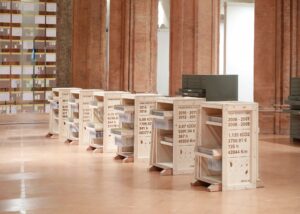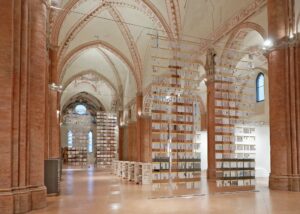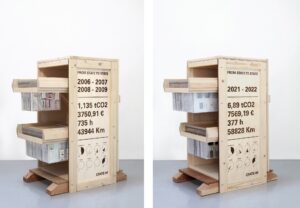According to the philosopher Thomas Nail, the continuative movement of people, goods, materials and information produced by mankind may be identified as the ‘Kinocene’: the age of movement. The dependence on mobility arising from globalisation causes a series of environmental phenomena that will, in turn, increase future global migration flows. Faced with this scenario, it becomes necessary to question these changes in relation to the importance of travelling, especially for artistic practices.

Diego Tonus, Da Stato A Stato, installation view, Abbazia di Valserena, CSAC Parma 2023, photo DT Studio, courtesy the artist and CSAC – Study Centre and Communication Archive of the University of Parma. The project was awarded the “PAC2021 – Piano per l’Arte Contemporanea”, promoted by the Directorate-General for Contemporary Creativity of the Ministry of Culture
From State To State by Diego Tonus invites viewers to question this ambivalent criticality. Defined by the artist as a ‘political portrait’, this work is a mobile archive testifying to all his journeys since 2006. It contains a long series of movements from one place to another and across numerous international borders. Aware of On Kawara and Roman Opalka’s time-specific practices, Tonus obsessively accumulated and meticulously catalogued more than three thousand travel tickets from 2006 onwards: trains, planes, subways, buses, etc. His quixotic attempt to capture movement in time and space is driven by the desire to observe these tickets as thought-triggering objects, to underline the importance of travel as an experience of sharing and as a moment in which new ideas are born. Paradoxically, it was the immobile lockdown world that prompted the idea of an itinerant physical archive. Together with the already existing digital database (www.fromstatetostate.com), the latter may even reach places where the artist has never been and add layers of new journeys.

Diego Tonus, Da Stato A Stato, installation view, Abbazia di Valserena, CSAC Parma 2023, photo DT Studio, courtesy the artist and CSAC – Study Centre and Communication Archive of the University of Parma. The project was awarded the “PAC2021 – Piano per l’Arte Contemporanea”, promoted by the Directorate-General for Contemporary Creativity of the Ministry of Culture
We may now discover it for the first time thanks to the recent acquisition by the CSAC – Study Centre and Communication Archive of the University of Parma. The project was awarded the “PAC2021 – Piano per l’Arte Contemporanea”, promoted by the Directorate-General for Contemporary Creativity of the Ministry of Culture, and it is currently on display in the Abbey of Valserena in Parma, in a show curated by Lorenzo Benedetti. The exhibition can be visited until 30 April 2023, and it is accompanied by the publication Diego Tonus. From State To State (Electa, 2023). Between the church naves, high vertical walls display the front and back of the travel tickets. As fragments and icons of contemporaneity, they stimulate a suggestive light effect in dialogue with the colours and atmospheres of the former Cistercian monastery. However, the six wooden crates on the floor attract the most attention, since they were specially designed to store dense rows of removable folders, containing tickets related to various years of Tonus’s travel.

Diego Tonus, Da Stato A Stato, installation view, Abbazia di Valserena, CSAC Parma 2023, photo DT Studio, courtesy the artist and CSAC – Study Centre and Communication Archive of the University of Parma. The project was awarded the “PAC2021 – Piano per l’Arte Contemporanea”, promoted by the Directorate-General for Contemporary Creativity of the Ministry of Culture
In its form, the archive recalls the famous curator Harald Szeemann’s Travel Sculpture: a source of inspiration for Tonus, who photographed it on the occasion of a trip to the Getty Research Institute in Los Angeles. Moreover, the crates evoke the image of the common transportation pallets. In this political portrait, therefore, Tonus presents himself as an artist on the move, or rather on a journey. The aesthetic chosen for the crates comes from research transversal to the idea of the archive, such as studies on the shapes of toolboxes, databases and maps, right up to transversal iconographic research such as the Friulian cramars: street vendors in Friuli whose rucksack-cum-shop window would be carried on their shoulders. Then there are projects such as Autoprogettazione by Enzo Mari, which served as an additional source of inspiration for the artist, and this is why it is specifically displayed on this occasion in the exhibition’s ‘Living Archive’ section in the CSAC Parma among other selected materials from the archive. Moreover, the crates well respond to the need for lightness of a mobile archive that will continue to travel by land and sea, but never by air, in order to limit CO2 emissions. In fact, drawing a political portrait, the artist seems to make amends for all his movements, specifying through numbers and graphs engraved on the side of each crate the means of transport used, the number of hours and kilometres travelled, the amount of money spent and of tonnes of CO2 emitted.

Diego Tonus, Da Stato A Stato, detail of shelving, photo DT Studio, courtesy the artist and CSAC – Study Centre and Communication Archive of the University of Parma
Therefore in the Kinocene, on one hand, archiving movement means becoming aware of the environmental impact of our travel. On the other hand, it deals with highlighting the consequences of our extreme mobility, while not giving up the desire to share and explore. Everything in Tonus’s work tells us about movement: not only the semantics of tickets, the shapes of the crates, the archive’s constant commuting between a digital and a physical state, but also its very interaction with the public. The observers move around the installation, they walk around the vertical walls while experiencing the space of the archive, they consult the crates, and they finally explore their contents through the digital database. From State To State is a living entity, constantly expanding into space, according to the Duchampian principles of archive expandability and according to a progressive dimensional growth which, moving from the millimetric thickness of the single ticket, reaches the monumental space within which one can walk. Lastly, the work moves across time, preserving the past, showcasing the present while acting within it, and finally, projecting itself both into a digital future and in the declared desire to interrupt the collection of tickets only upon the artist’s death.

Diego Tonus, Da Stato A Stato, L’archivio fisico – Cassa #1 (2006-2009) e Cassa #6 (2021-2022), photo DT Studio, ccourtesy the artist and CSAC – Study Centre and Communication Archive of the University of Parma
Not only does the author archive his own movements by retracing the geographical limits and boundaries drawn by his various journeys, but he also preserves the economic value of the archive, which is equivalent to the sum of all the tickets it contains. The price of the work, purchased in this context by the state, triggers a discourse in which the journey is recognised as a constituent part of the artist’s work. Afterall, it is the same state that has monitored, recorded and controlled every movement made by the artist over the last seventeen years. In turn, Tonus watches it, records it, and controls it through his own collecting practice, triggering a fair subversion of the Foucauldian power and control practices that accompanied each of his journeys. From this point of view, his work also becomes a new form of geographical mapping that displays the new ontology of state borders. Indeed, they no longer assume the image of a line on the ground, but rather that of a set of political and discursive in/exclusion processes, embodied in the privileges guaranteed by the possession of a specific passport and specific origins. As long as we explore it, From State To State turns out to be this and much more. For Tonus, accumulation as a work is a subversive practice of the forms, functions and structures of the archive. In it we have the chance to outline the new forms of contemporaneity, the new global geopolitical systems and future scenarios. To grasp all of this, we need to enter the archive, to move around within it and with it towards the perspectives that it presents us with, more or less directly.
Andrea Masala
Info:
Diego Tonus. From State To State
curated by Lorenzo Benedetti
25/02/2023 – 30/04/2023
Talk, Book launch: 28 April 5.30 pm CSAC – Abbey of Valserena
CSAC –Study Centre and Communication Archive
Abbey of Valserena, Strada Viazza di Paradigna, 1 (Parma)
www.csacparma.it

is a contemporary art magazine since 1980






NO COMMENT